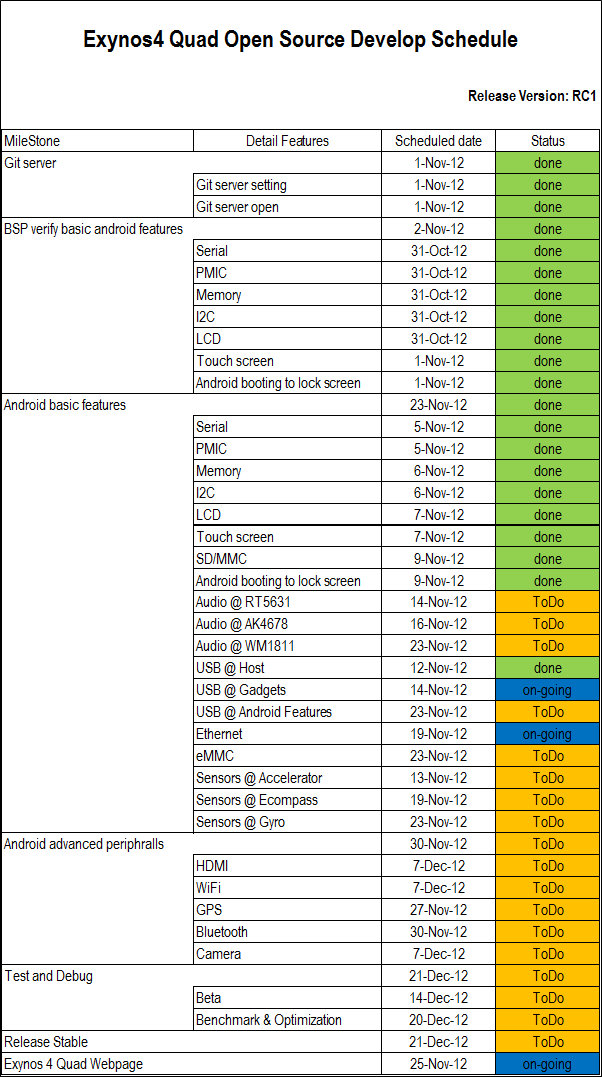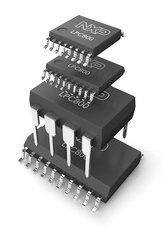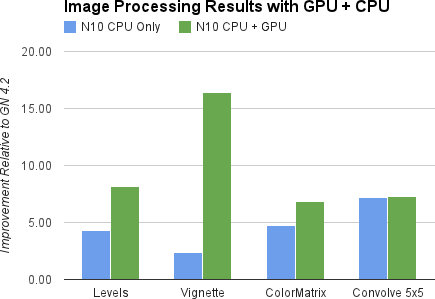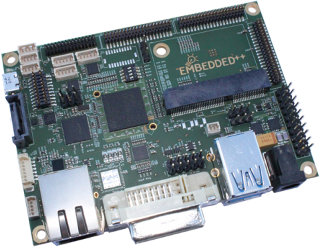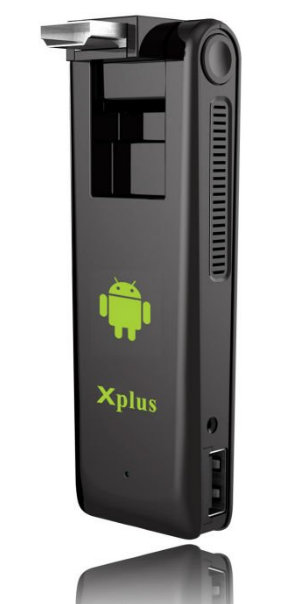congatec AG has introduced a new reference board for video wall system design. This reference design is based on a baseboard, an AMD Embedded R Series APU COM Express CPU module (conga-TFS) & an optional AMD Radeon E6760 GPU MXM module, and can support up to 9 independent displays. The video wall baseboard includes a wide range of ports and features for embedded applications such as : Video Output – VGA, 18/24Bit single/dual channel LVDS, 3x DisplayPort 1.2, 1x HDMI 1.4 and 2x single-link DVI (All ports are available when both the CPU and MXM graphics modules are used) Ethernet – 2x Gbit Ethernet SATA – 4x SATA (for 2.5″ SATA or SSD) USB – 4x USB 3.0 and 4x USB 2.0 PEG Port 2.0 7x PCI Express 2.0 x1 lanes RF4CE (ZigBee) receiver enabling remote control 19V power supply for standard notebooks Developers can optionally integrate an additional graphics […]
ISEE is Working on IGEPv5 Board with TI OMAP 5 and Needs Your Feedback
ISEE IGEPv2 is a low cost development board based on TI DM3730 (Cortex A8) that is relatively popular with the development community, used by Free Electrons for their embedded Linux training courses, and part of a List of 39 Low Cost Linux Friendly Boards and Products I published earlier this year. Yesterday, Michael Opdenacker, founder of Free Electrons, wrote a blog post saying ISEE was working on IGEPv5 development board based on Texas Instruments OMAP5 dual core Cortex A15 processor that can run up to 2 GHz, supports DDR3 RAM, full HD 3D recording, and 4 displays and cameras simultaneously among other things. This is still early development and the board exact features have not been defined yet. ISEE is actually looking for the community feedback to provide the best board possible and you can leave your inputs and expectations by commenting on Free Electrons blog. You could have a […]
Kontron ULP-COM-sAMX6i – Freescale i.MX6 Solo, Dual and Quad Computers on Module
Freescale i.MX6 series was first announced in January 2011, and there have been delays due to problem with the silicon, but now the i.MX6 processors are finally in mass production, and lots of different products are using this SoC. The latest product I found is ULP-COM-sAMX6i by Kontron which is a series of computers on module based on ULP-COM (Ultra Low Power) standard featuring Freescale i.MX6 solo, dual and quad processors. Those commercial and industrial grade modules target markets such as transportation, medical and military. Here are the technical specifications of the modules: CPU – Freescale i.MX 6 Single, Dual and Quad Core ARM Cortex-A9 @ 800 MHz (Industrial grade), 1 GHz and 1.2 GHz System Memory – Up to 2 GB DDR3 Storage – Optional onBoard NAND/eMMC up to 64GB Graphics / Video – Dual Display, HD 1080p Decode/Encode and 2D/3D acceleration Video Output Resolution Parallel LCD 18/24 bit […]
Samsung Exynos 4412 (Origen 4 Quad Board) Open Source Development Schedule
If you’ve got an Exynos 4412 development board such as Hardkernel ODroid-X or Insignal Origen Quad, or even other devices based on Exynos 4412 such as the Samsung Galaxy S3, you may be interested to know the open source development schedule for the platform as show below (Source: Origenboard.org). Samsung already released the source code for Samsung Galaxy S3 in June, but this should add more recent drivers and support for more peripherals. The stable release should be available on the 21st of December 2012, but in the meantime, you could always pickup features earlier as they are being implemented. The code is available in http://git.insignal.co.kr/ (Git repository) and is maintained by both Insignal and Samsung. Jean-Luc Aufranc (CNXSoft)Jean-Luc started CNX Software in 2010 as a part-time endeavor, before quitting his job as a software engineering manager, and starting to write daily news, and reviews full time later in 2011. […]
NXP Launches Cortex M0+ LPC800 MCU and $15 LPC812-LPCXpresso Board
Following ARM Cortex M0+ announcement in March 2012, NXP Semiconductors has just announced the LPC800, tiny 32-bit MCUs based on Cortex M0+ core @ 30 MHz designed to replace 8-bit MCUs, together with LPCXpresso development board for the LPC800. The MCUs come with 1 to 4KB SRAM, 4 to 16 KB Flash, several serial interfaces and are available in SO20, TSSOP20, TSSOP16 and even DIP8 packages. Here are the key features of NXP new ultra low power 32-bit MCU family: ARM Cortex-M0+processor up to 30 MHz, software compatible with Cortex M0, M3 and M4 cores Memories: 4 to 16 kB Flash (with 64 Byte page size) 1 to 4 kB SRAM Serial Peripherals: Up to 3 USART interfaces Up to 2 SPI controllers 1x I2C-bus interface Timers: Multiple-channel multi-rate timer (MRT) State Configurable Timer (SCT) Self Wake-up Timer (WKT) clocked from either the IRC or a low-power clock source Windowed […]
Android Jelly Bean 4.2 SDK, Source Code and Binary Images Are Now Available
As the Nexus 4 smartphone and Nexus 10 tablet became available for purchase yesterday, Google released Android 4.2 SDK for developers and pushed Android 4.2 to AOSP. The Android 4.2 (Jelly Bean) SDK platform (API level 17) brings the following key improvements: Performance – Renderscript computation can be run directly in the GPU on the Nexus 10. This is a first since Exynos 5250 is the first ARM processor capable of supporting GPGPU (via Mali-T604 GPU). See the chart of the right showing results between CPU and CPU+GPU computation of some multimedia benchmarks. Lock screen widgets – Users can now place interactive lock screen widgets directly on their device lock screens. This only requires a small update to adapt existing widgets to run on the lock screen. Daydream – An interactive screensaver mode that can be used when the device is charging or docked to a desk dock. Better external […]
Texas Instruments OMAP 5 Cortex A15 Systems-on-Module Galore
Today Texas Instruments published a press release to announce partners 6 company had worked to design and manufactures systems-on-module based on the dual core Cortex A15 OMAP 5 SoC and that those would be on display at Electronica Trade Faire this week (13-16 October) in Munich. Embedded++ EPP-Pico-OMAP5430 This solution is actually a Pico-ITX board based on OMAP5430 with 2 GB LP-DDR2, USB 3.0 SuperSpeed connectivity (1x USB 3.0, 3x USB 2.0), up to 16 GB eMMC storage, a SATA port, a 100Mb Ethernet port , UART, RS-323 & SPI ports, GPIOs, DVI and LVDS outputs, a serial camera input port, a micro SD card socket, Murata WiLink 8.0 connectivity solution (Wi-Fi, GNSS, Bluetooth®, Bluetooth v4.0 and FM technologies) and a built-in battery charger (1-cell Li-Ion). The company provides Linux and Android 4.1 BSP. Check the product page for a few more details. GreenBase GK-5432 GK-5432 is a computer on […]
Jesurun Xplus H25 Mini PCs with Rotating HDMI Port, DLNA Support
Jesurun Xplus H25 mini PCs are typical Android 4.0 AllWinner A10 and Rockchip RK3066 mini PCs, expect for one slight mechanical difference: The HDMI male port can rotate and possibly allow the mini PC to be inserted directly into the TV in case where other may not. Of course, one option could always be to buy a cheap HDMI rotating adapter or an HDMI cable to connect the device, but I find having this option within the device is neater. Let’s look at the specs of the single core version: SoC – AllWinner A10 with Mali-400 GPU System Memory – 1GB RAM Storage – 4GB NAND Flash + TF card slot USB – 1x USB 2.0 OTGX + 1x USB HOST + 1x mini USB HOST WiFi – 802.11b/g/n Video Container Formats – AVI, MKV, TS, TP, TRP, M2TS, MPG, MP4, M4V, MOV, VOB, MVC(3D) ISO, IFO, DAT, WMV, ASF/RM, […]





